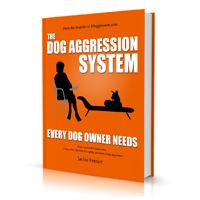Your cart is currently empty!
Controlling dog aggression by using a dog muzzle
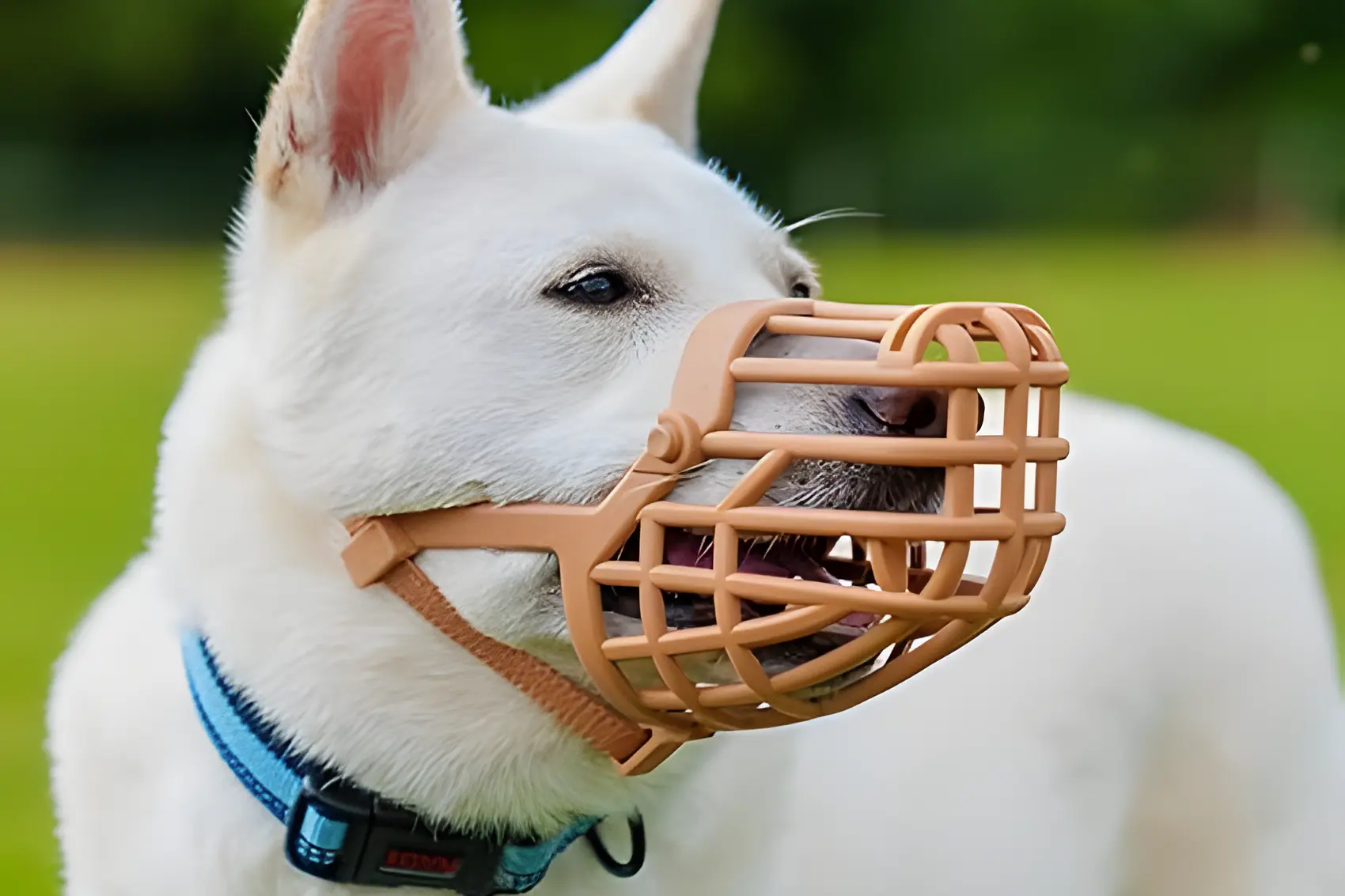
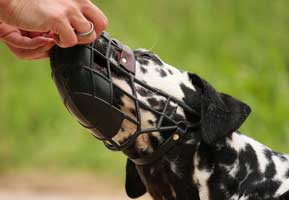
Dog aggression can be stressful for pet owners. Ensuring the safety of your dog and others is crucial. A dog muzzle is an effective tool in managing aggressive behavior.
A well-fitted muzzle can provide peace of mind, allowing you to handle your dog with confidence in various situations. However, while a muzzle can prevent bites, it does not address the underlying causes of aggression. This guide will walk you through everything you need to know about choosing, fitting, and using a dog muzzle responsibly.
In this article
Jump to:
Which Type of Muzzle is best for my situation?
Jump to:
Although there are many variations on the market you generally see either:
- Wire or plastic basket muzzles.
- Softer variations are usually made of some kind of fabric such as nylon.
- Leather muzzles that cover a large part of the dog’s face.
- Novelty muzzles shapes as duck beaks, etc.
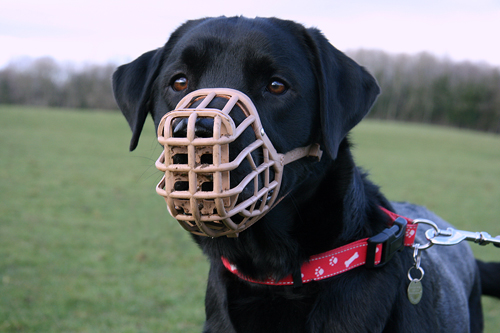
Muzzles for Aggression
Short Answer: Basket Muzzles are best for aggression
For the average dog owner who wants to exercise caution while training their dogs not to be aggressive or out for walks, the basket muzzle is the most humane choice recommended by veterinary behaviorists. Basket Muzzles allow your dog to pant and open its mouth. You need a good quality muzzle that will withstand potential fighting and will not rip, bend, or otherwise fail. Ideally, you need to be able to give treats through (food tubes are good for this).
More on Basket Muzzles
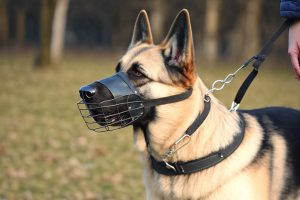
- USES: Bite prevention during longer-term use such as training or going on walks
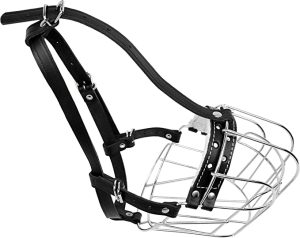
A basket muzzle is the best muzzle to use for aggressive or reactive dogs because it minimizes anxiety and fear. (1) (2) Allowing dogs to pant and open their mouths which is extremely important. Dogs pants for any number of reasons including dogs that are panting to get more oxygen due to exercising, dogs that need to regular their temperature in warmer weather, or any dog who is panting because of stress.
You may need to try a variety of different shapes and fit depending on the shape of your dog.
Potential considerations with basket muzzles
- Some plastic muzzles tend to be cheaper, but they don’t tend to let in as much airflow so you need to consider what activity you are doing with your dog.
- Some dogs can get their lower jaw out and get teeth stuck with certain kinds of muzzles.
- Dogs may be able to bite through a soft or cheap plastic muzzle.
- Straps, fastenings, and muzzle itself should be checked regularly for damage
- Muzzle should be cleaned reguarly
The airflow is best with wire basket muzzles. The ability to give your dog a treat through the muzzle is a little easier, too. However, the wire muzzles tend to be a little heavier and dogs can still hurt others by hitting them with the muzzle.
Recommended Basket Muzzles
The products we recommend are carefully chosen because we genuinely believe they are the best options to help you and your dog. As an Amazon Associate, we earn from qualifying purchases made through some of the links on our site. These commissions help us cover costs like web hosting, so we can continue providing helpful content for free. Look for #commissionearned near the links.
Dean & Tyler Muzzles
Dean & Tyler has been a trusted brand for dog muzzles for years.

Consistently the Dean & Tyler brand wire basket muzzles on Amazon (#commissionearned) received excellent reports for quality and value over the years and have come recommended by many dog owners. Once bought you should never need to buy one again.
The Dean and Tyler brands have good fitting guides on their site, but you can usually find them for less on Amazon than buying direct.
The Dean & Tyler Freedom Muzzles (#commissionearned) is their most spacious basket muzzle and has received excellent reviews and is suitable for medium to extra-large dogs. Dead & Tyler has a “winter” version which is the wire covered with rubber. These muzzles are good for those living in colder climates and allow your dog to drink and take treats as well as allow a wide range of jaw movement.
You will need to check the sizes for your dog. They come in many more sizes than the Baskerville.
Baskerville Ultra Muzzles
Baskerville is also another trusted brand that has been around for years.
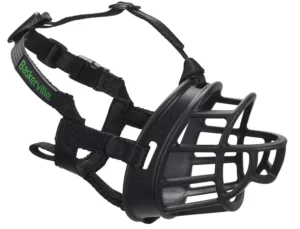
Baskerville Ultra Muzzles (#commissionearned) (look for the size that fits your dog – the default option is a size 5) also scored well for dogs with larger heads such as Staffordshire Bull Terriers, Pitbulls, etc.
This brand has consistently received good reviews and you can often buy them for less than the Dean & Tyler and Jafco muzzles.
Some styles have been reported to rub the skin against the nose of some dogs and there is a slightly more restricted airflow than the wire basket muzzles. They come in several different sizes.
The advantage of this muzzle is that the rubber version is typically lighter than the wire basket muzzles. They are relatively easy to feed treats through.
Jafco
Jafco Muzzles are high-quality muzzles. Many Veterinary Universities such as PennVet Behavior Medicine Clinic use Jafco muzzles at their hospital (1) as well as other training professionals. These are plastic muzzles that have some flexibility to them so if the dog hits you with one, it doesn’t hurt as much as the wire ones.
Jafco Muzzles have been the first choice of some veterinary behaviorists and many training professionals. (1). However these are no longer as easy to find as they once were. You might be able to get them through your veterinarian. Check where to find these on the Jafco site.
SEE ALSO: 6 other ways to keep others away from your dog
Giving food rewards:
Giving food rewards is essential for behavior modification and communication. Cut a hole at the front of plastic or rubber muzzles to make a larger hole to give them treats through the muzzle. Alternatively, using a popsicle stick with peanut butter, spreadable cheese or meat, or using a food tube all can work as well.
How to Fit a Dog for a Basket Muzzle

Most muzzles are adjustable. However, dogs come in all sorts of different shapes and sizes, even between breeds. What works for a greyhound with a narrow head is not going to work for a pitbull type with a wide jaw. Therefore you might want to build in your budget additional shipping costs in case you need to return a muzzle if it does not fit properly.
- The strap around the neck needs to fit quite snuggly so the dog cannot paw it off or catch it on anything.
- Ensure that there is enough room in the basket part of the muzzle for your dog to pant.
- Make sure that the muzzle is not too small, but also that it is not too big.
- Desensitized and counter-condition dogs to wear a muzzle in order to make it a pleasurable experience.
Muzzles for Grooming or Vet Visits
Short answer: Basket Muzzles are best, Occulsion muzzles or Cute/Funny muzzles can still be used for certain situations.
Basket muzzles are the most humane, but for temporary uses, occlusion muzzles are acceptable and because they are relatively easy to put on may be a good choice. However, they may cause your dog some stress since they can’t pant or open their mouths easily.
More on Occlusion Muzzles
- USES: Use occlusion muzzles for short-term use only for vet visits or grooming
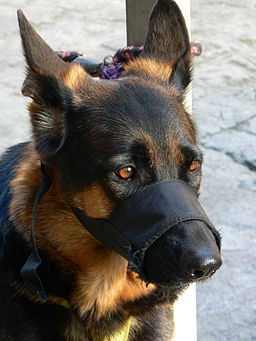
“Occlusion” muzzles that shut the dog’s mouth completely. They are usually made of fabric. Using a muzzle may prevent the dog from opening its mouth widely can increase anxiety and fear (1). Never use an occlusion muzzle for a long period of time. They may be fine for temporary use such as at the vet or grooming. The advantage is that they can usually be put on relatively quickly.
They should not be used to prevent barking. If your dog is barking excessively, it may be a result of boredom or there may be an anxiety issue that can be resolved. In this case you should consider getting a veterinary behaviorist consultation to diagnose the issue.
It is also possible that dogs can still nip if they can get their mouths at all open.
Dangers and considerations associated with occlusion muzzles
- Because dogs cool themselves when they are panting, these muzzles can pose a threat to the dogs wearing them. Avoid using Occlusion muzzles when especially warm or when they are stressed and need to pant. Panting is the only way a dog can cool down, so if worn too long in warmer weather, it can cause heat stroke resulting in serious harm or even death.
- Dogs can find occlusion muzzles extremely frustrating
More on “Cute” or “Funny” Muzzles
Duck muzzle (#commissionearned) The idea is great, but sadly, they are only good for short-term situations where the dog is unlikely to pant which rules out using them for aggressive dogs when out for a walk or when you have visitors. Like the occlusion muzzles, they may be fine for temporary use such as at the vet or grooming. The advantage is that it may make others around them feel less threatened by the fact they are wearing a muzzle.
Dangers and considerations with cute/funny duckbill muzzles
- If the temperatures are warm, or a dog is likely to be anxious, they should be avoided. Do not use these muzzles for walking or any situation where a dog needs to pant.
- The cute concept may encourage kids to approach which may not be a good thing for an anxious dog.
- Many have reported that these muzzles are far too easy for the dog to pull off.
Cute or Funny muzzles may be useful in veterinary situations when you need to wait in a waiting room with other people and you don’t want other people acting fearful of your dog and contributing to your dog’s stress. Ensure these muzzles are well made.
Muzzles For Protection Training
Short answer: Leather Police Style or Agitation Muzzles are best for protection training.
These dog muzzles are usually used for police or protection training where the dog is encouraged to bark and bite. They are usually made of leather, although plastic variations exist. The leather variations allow the handler or target of the aggression to experience less damage if they are hit hard with them. While leather agitation muzzles are considered the safest from a bite perspective, they are also the most expensive. Your trainer will likely have recommendations for your dog.
More on Police style or “Agitation” dog muzzles
- USES: teaching dogs to bite for police or protection training
You can see different types and prices on Amazon for “agitation training” muzzles #commissionearned.
Dangers and considerations associated with Agitation muzzles
- Ventilation is still a concern with these muzzles. Examine how well-ventilated the muzzle is that you are looking at.
- Getting the right fit is also important since it is more difficult to see how well the dog fits inside of it.
If you decide on one of these muzzles for a dog you are working with to NOT be aggressive an important consideration is how easily you can feed treats through. Using a muzzle with behavior modification or training, the ability to give a treat to your dog is essential. Some muzzles will allow you to put a popsicle stick with peanut butter, spreadable cheese, or puréed meat, and as with some plastic or rubber basket muzzles, some muzzles can be cut through to make giving treats easier.
Muzzles for Barking
Muzzles are generally not recommended as a primary solution for barking for several reasons:
- Stress and Anxiety: Using a muzzle to prevent barking can increase a dog’s stress and anxiety. If a dog is barking out of fear, stress, or anxiety, putting a muzzle on them may exacerbate these feelings. They may stop the behavior while the muzzle is on, but once it is removed, the dog is likely to resume barking potentially to a greater degree.
- Risk of Misuse: Muzzles need to be used correctly and for appropriate situations. Misuse can lead to physical discomfort or injury particularly while under stress. Muzzles should not be used for extended periods, and dogs should always be supervised while wearing them.
- Communication and Expression: Barking is a natural way for dogs to communicate. By muzzling a dog to stop barking, you might be preventing them from expressing themselves, which can lead to frustration and other behavioral issues.
- Training and Behavior Modification: It is more effective to address the root cause of barking through training and behavior modification. Techniques such as positive reinforcement, desensitization, and counterconditioning can help reduce barking by addressing the underlying issues.
If a dog’s barking is problematic, it’s essential to identify why the dog is barking and work with a professional dog trainer or behaviorist to develop a comprehensive plan that addresses the root cause of the behavior.
When to use a dog muzzle

Vet visits
Vet visits can be stressful to dogs for a number of reasons and bites are more likely to happen. Most vets appreciate that you have thought to muzzle your dog if there are any concerns. However, check with your vet about whether they think muzzling your dog is a good idea during the visit. If your dog is aggressive towards other animals, it might be possible to keep your dog in your vehicle until the vet is ready to see your dog.
Neighbourhood or park walks
If your dog has the potential to bite, safety should always come first. The first step it to prevent your dog from becoming anxious by avoiding the things that set them off. But surprises and accidents happen so make sure your dog can’t bite by using a muzzle. It is a good idea to reinforce the link between muzzles and enjoyable walks
During training or behaviour modification
You should avoid the things that trigger your dog’s aggression except when doing behavior modification. However, do not trigger the aggression by getting too close – see the importance of getting your dog’s attention at the first sign of arousal. Use a dog muzzle only as a safety precaution only.
To help encourage people to keep their distance
Muzzles encourage people to keep their distance! If you are interested in keeping people at a distance check out our article on other things that can help keep people and or dogs at a distance.
To regain your confidence
If you have experienced an aggressive conflict you may be feeling anxious yourself. Dogs can pick up on that and become more anxious in response. Knowing that your dog can’t bite might help you feel calmer.
When NOT to put a muzzle on your dog
- When leaving your dog unsupervised
- If your dog is required to wear one for an extended period of time
- As an attempt to prevent barking
- As an attempt to prevent your dog from grabbing something
What if my dog doesn’t like to wear a muzzle or I can’t put one on?
If you’ve tried a muzzle or head halter and your dog didn’t like it, you’re not alone. Many dogs find wearing a muzzle uncomfortable at first. They might paw at it, refuse to cooperate, or even act out. This doesn’t mean your dog can’t wear one—it simply means they need time to adjust. With the right approach, you can help your dog feel more at ease and even look forward to wearing a muzzle. Learn more in our article What If Your Dog Won’t Tolerate a Muzzle?
Are there any issues with Muzzles?
When dealing with an aggressive dog, using a muzzle can feel like an immediate solution. However, while muzzles can be effective in specific situations, they’re not without drawbacks. Learn more about Issues and Alternatives to Dog Muzzles for Aggressive Dogs.

Make your dog a safer pet with a systematic approach than relying on a muzzle only.
Here are some basic steps:
- Identify signs of stress: Learn how the body language that indicates stress or anxiety in order to act before the aggression even starts.
- Prevention: Create a prevention and management plan to help you avoid the circumstances that are causing the aggression unless you are specifically working on behavior modification.
- Establish a treatment plan: Help your dog learn to cope better and teach your dog alternative behaviors with a treatment plan designed to keep his anxiety below “threshold” through humane treatment methods.
In conclusion
Regardless of whether your dog is aggressive, we often put our dog into situations where they cannot escape and/or don’t feel safe. Dogs have few tools at their disposal to ward off threats if their warning systems, (such as barking, growling, or lunging) fail. So training your dog to wear a muzzle is a good idea. They can also be useful for situations where your dog might be experiencing pain or fearful situations and may be an excellent idea any time children are around.
A muzzle won’t prevent an aggressive dog from getting worse, and exposing them to situations that cause their anxiety to increase can make the situation worse. Whenever possible a treatment program that includes behavior modification, as well as other measures will be more humane for your dog in the long run.
Learn more about creating a dog aggression treatment plan in the ebook The Dog Aggression System Every Dog Owner Needs.
You might also be interested in
6 Other Ways to Keep Others Away From Your Dog
5 methods to avoid in dog training
Using a head halter for an aggressive dog
References
* Disclaimer: K9aggression.com is a participant in the Amazon Services LLC Associates Program, an affiliate advertising program designed to provide a means for sites to earn advertising fees by advertising and linking to amazon.com. That means we earn a small commission from any product listed here linked to Amazon should you decide to buy any of them on Amazon at no expense to you. This helps us keep our site up and maintained so we can continue to help people help their dogs. We never recommend anything that we don’t believe will be of value to you. Please do not by anything that you don’t need or feel is not useful.
ADVERTISEMENT
The Dog Aggression System Every Dog Owner Needs E-book
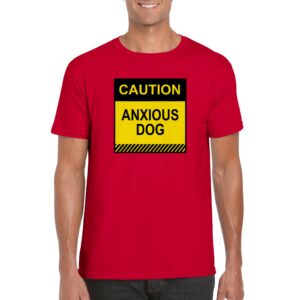
Anxious Dog Shirts only available in our shop
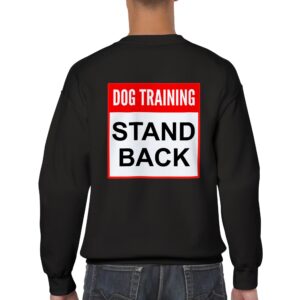
Keep people away with our Stand back shirts

